A Paipo
Interview with Dave Sams
December 20-26, 2014 - Newport, Australia
E-mail and phone interview by Bob Green
Dave
Sams grew up on Sydney's northern beaches and would go on to visit
Hawaii several times, developing friendships with some renowned
Hawaiian surfers. His link to Hawaii began in 1964, when he wrote to
John Kelly, the author of the classic book, Surf and Sea.
Dave had been riding finned bellyboards but wanted to ride a finless
paipo like he'd seen in a movie. Amazingly, Dave kept the letter from
John Kelly.
|
1. What
inspired you to ride a bellyboard/paipo?
I started bodysurfing in 1958, and also
branched out into coolite boards and surfoplanes about 1960 [see Note 1
for information on coolites and surfoplanes]. Purchased a balsa
bellyboard about 1963, with two fins, and then a so-called paipo board
a little later which I think was made of cedar and also had two fins.
I had seen shots of Jim Growney and John Waidelich at Waimea, probably
in a Bud Browne movie, and was wrapped in how fast they were going [see
Note 2
for more info and links to a paipo interview with Jim Growney and video
footage of Growney and Waidlich]. It was then that I bought the second
board mentioned above which someone who had come back from Hawaii
claimed was the authentic design. Although I realised that it was not
what I had seen on film it went well and I recall that at Easter 1964,
there was a solid Easterly swell running and I rode this boardt at the
Bower, the inside section off the end of Long Reef where it swings
South near Lil Makaha, North Narrabeen, with only a couple of other
boardriders, The Path at Newport and the north end of Bungan.
Were these boards like the photos I sent you?
One
board in the photos (see below) looks very similar to my first board.
It was more or less a slab shape. No handle. It was pretty straight and
there was no real kick in the nose at all. From memory my second board
was a delta shape but with fins at the back.
A late-1950s bellyboard
similar to Dave Sams's first board.
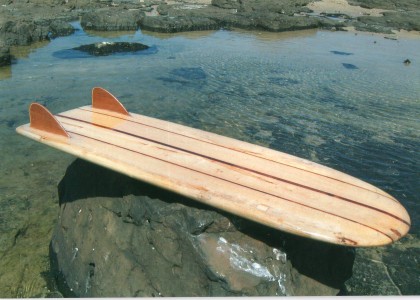
Photo courtesy of Colin Harper.
I read in an article about a book, Surf
and Sea,
written by John Kelly of Hawaii, so I thought he should know what the
“real” paipo board was that I had seen on film. The article included
his address so I wrote a letter to him, in April 1964 [see Note 3].
Could it have been a Val Valentine movie?
I know Val Valentine was into paipo boards. I met another bloke, as I'd
been to Hawaii a few times, Paul Swanson, who also rode paipo boards
[for more information on Val Valentine and Paul Swanson, see Note 4].
So you met Paul Swanson? Was he riding a paipo then?
From memory yeah. I met him in the 1966-67 season. His daughter, Karen,
is living in the States. Mozell Angel, who I still see in Hawaii, sort
of keeps in touch with her. I got to know Jose Angel and his family
pretty well. I first went over in 1966, then back in 1967 and 1970, but
then it was about 30 years before I got back to Hawaii. I was there
last year.
Did you surf with Paul Swanson?
I met him because he was a mate of Jose Angel. He was also a mate of
John Vogler, another bloke I met over there, who had moved from Malibu
and through him I met some of the Californian surfers, e.g., Pete
Peterson and Don James. I saw Paul Swanson when I went back there in
1967, but I'm not sure if I saw him in 1970.
Do you still see people riding paipo boards in Hawaii?
They're still around. You see them every now and then, it gives you a
bit of a kick to see someone doing it.
2. What did you base the design of your first board on?
The balsa and cedar bellyboards mentioned above I think were bought
from Denny Keogh who had also made my first surfboard.
However when to my surprise John Kelly answered my letter (see below)
he enclosed drawings and I think measurements on tracing paper. I
copied them fortunately as the original plans were
mislaid when I had the second board made up.
The envelope containing
John Kelly's letter.
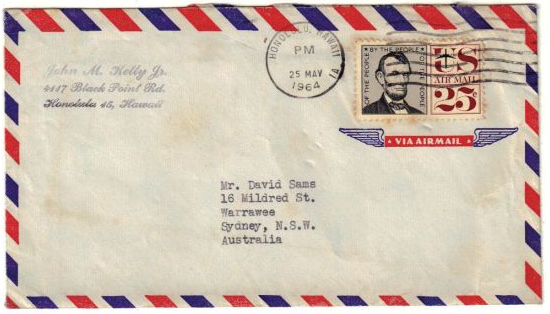
Figure courtesy of Dave Sams.
Letter from
John Kelly and Sams's copy of the enclosed drawings.
|
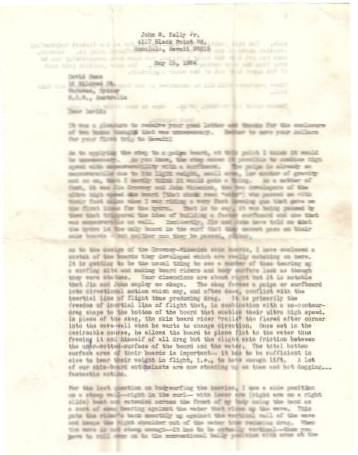
|
|

|
Figures courtesy of Dave Sams.
3. How did you end up getting Bill Clymer to make the
board? What
was involved? Did he take much convincing? What year was this?
As soon as I received John Kelly’s letter in
May 1964, I went to Gordon
Woods (can’t recall why) and after he looked at the plans he suggested
I see Bill Clymer as Gordon thought that this was more in Bill’s line
of expertise [see Note 5].
Bill’s factory was at 1 Campbell Parade and I went over and spoke to
him and he was quite interested and said he would get his apprentice to
shape it for me. I don’t know the name of the apprentice but he shaped
it out of solid cedar and did a beautiful job. I had it glassed at
Gordon Woods and the glasser also did a top job.
The cedar paipo
made at Clymer's factory based on John Kelly's drawings.
|
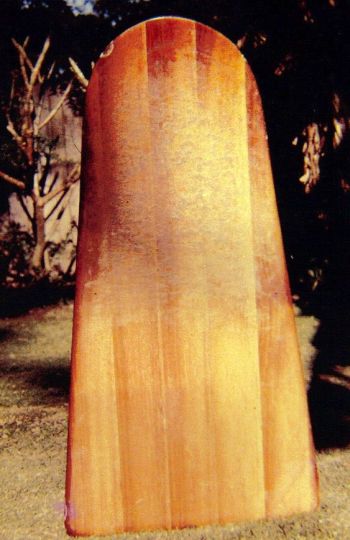
|
|
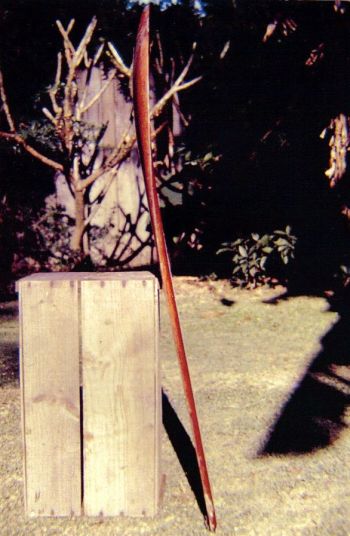
|
Photographs courtesy of Dave
Sams.
Mind you the board cost as much as a full sized surfboard, but I was
just so stoked to have the real deal I paid up without question.
4. What do you recall about this board's dimensions and
design?
Not
a lot to be truthful. I guess it was about 4-foot-long but the only
thing
I can relate it to is the photos which shows it relative to a fruit
packing case. It was a grind paddling, but I had a pair of Turnbull
Giant flippers and also used my arms to paddle so it was workable. A
breeze to duck dive though and I rarely lost it. The scoop at the
front usually stopped you nosediving although I did nosedive once and
began to bodysurf until I thought I had better rescue the board!
5. Where did you mostly surf the board?
I mostly surfed it at Bungan, Newport Reef/Pool
and South Avalon. There
weren’t many riding bellyboards at the time from my memory. I had
some
big days at Newport Pool and it went like the proverbial on the walls
there, and also a couple of big days at South Avalon, but I mostly rode
it at Bungan.
(Below
left) Newport Pool on a fair-sized day showing the long wall in 1969.
(Below right) A big day at Newport Reef, April 1971.
|
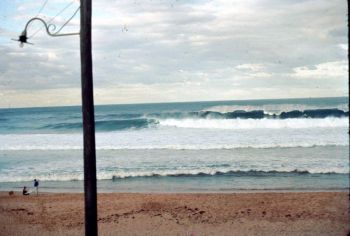
|
|
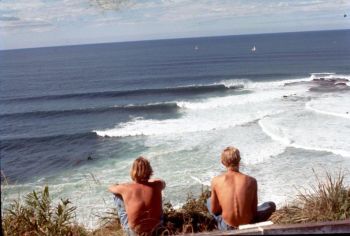
|
Photographs courtesy of Dave
Sams.
Were there any others riding bellyboards at the time?
Pete Sobels of Avalon was one, but I didn’t see anyone with one like I
had.
Do you know him?
I
haven't seen Peter for 30 or 40 years. His old man ran a timber yard
and I think Peter went into the business. He was in Avalon surf club
but he sort of dropped out of surfing in 1967, or something like that.
He
went to Hawaii with a bellyboard in 1965/1966, which he rode on the
North
Shore.
Do you remember what sort of board did he have?
I'm sure it had fins.
Pete Sobels at Newport
Pool, 1966.
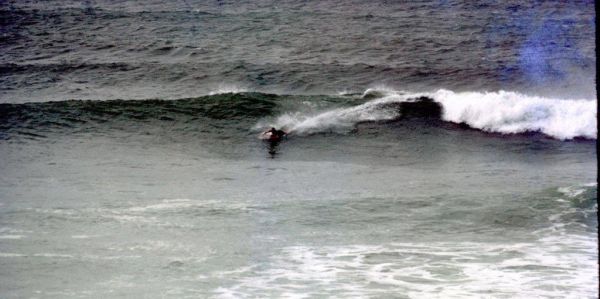
Photograph courtesy of Dave
Sams.
6. How did the speed of these boards compare to the
stand-up boards?
I
always tried to get waves on my own, but on the odd occasion when I did
share a wave with a board it was at least as fast and usually I could
pass them.
What technique was involved in riding these boards?
It was pretty much, having your inside arm stretched out and the other
arm was hanging onto the rail, but near the front. If you were going
right, your inside (right) arm was out, forward on the board and your
left hand would be back from the nose, but on the rail. If you cut
back, you might put your left arm out and forward and rotate your body.
What's known as the superman or outrigger arm style?
Yes, that was pretty much what I was doing. It was a natural reaction as
otherwise your elbow on your inside arm would be in the wave or
something like that.
An example of riding superman/outrigger style with the wave face arm extended. Jim Growney riding across a Sunset Beach wall.
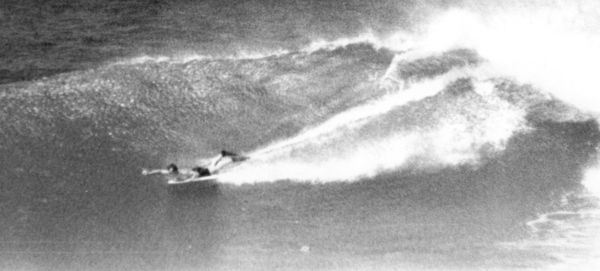
Source: Valentine, Val. (1965,
January). It's Smaller, Faster and 300 years Old: The Paipo Board. Surf
Guide, 3(1), 17-19. Photograph by Val Valentine. [Note: In the article Jim Growney is incorrectly identified as Jim Brownie.]
Would you use hip pressure?
There were
probably things you were doing unconsciously, things you had to do.
Sometimes you'd hang onto it with both hands going down the face.
Mainly, whichever way I was going to turn that arm would be out front.
7. How many boards have you had over the years? Did the
design change much?
I had two paipos made by Clymer/Woods. I lost
the first one off the
roof of the car on our first trip up North, probably an indication of
what would go wrong as I finished up writing the car off on the way
back.
I rode it for probably only 10 to 12 months full time as at the end of
1964, I managed the monumental feat of standing up on my surfboard.
After that I used the paipo when it got big or good, but as I
gradually improved on the board it took over.
I rode the paipo only on rare occasions after 1965, and by 1966, it was
pretty much all surfboards.
Farrelly gun. A beautiful
board and an absolute rocket, ca. 1968.
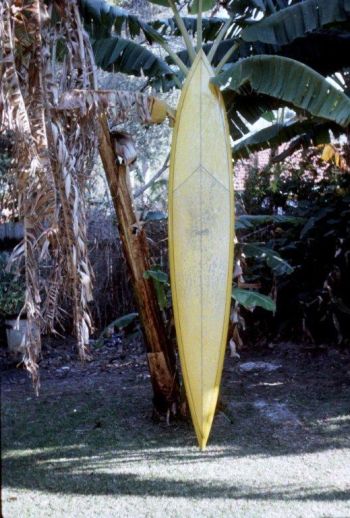
Photograph courtesy of Dave
Sams.
I lost the paipo board in the landmark storm of May 1974. It was in the
clubhouse at Bungan Beach SLSC which was partly washed away. The paipo
board finished up in the middle of the beach with all the glass on the
deck stripped back to the nose. I intended to rescue it but got caught
up in shifting the mess in the club and when I went to find it later
that morning it had disappeared, probably out to sea.
The racetrack section at
8- to 10-foot Fairy Bower, August 1967.
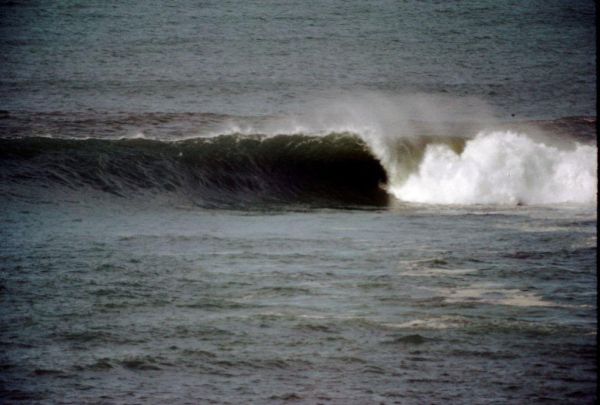
Photograph courtesy of Dave
Sams.
8. What has been the attraction of riding a paipo?
Basically
the attraction was the blistering speed which being so close to the
wave face felt like a million miles an hour on a decent size wave. That
and the ease of duck diving.
Half the attraction in a way was that you were on the borderline
between being out of control and not losing it. There were times where
it was pretty much on the edge whether you were going to bloody hold in
or not. You were doing a million miles an hour and at that stage that
was 90 percent of the attraction. It certainly held in on waves. I
can't
remember it dropping out or anything like that.
9. What sort of waves were your boards most suited to?
Any waves or surfs from over the years still stand out for you?
The boards worked well in any sort of surf with
a bit of push, but when
the wave had a long line on it was the best because you could just let
it rip from as far inside as you were game.
Probably big days at Newport Pool and Reef, South Avalon and the north
point at Bungan were where I had my best surfs on the board. One
particular day at the Pool, I made it out during a lull with a couple
of
mates on boards. Once we got out there we had to sit wide as there were
maxed out sets and if you sat in position for medium sets you would get
cleaned-up. Ron Ware paddled out in a lull and chided us for sitting
“on the shoulder” until big black lines marched round the end of the
reef and we all headed for the hills. None of us made it but I managed
to duck dive OK and the others started the swim in. A similar set came
in about 10 minutes later and I took off on the second one but I was
going so fast down the face my flippers nearly came up over my head in
a full cartwheel which would have meant annihilation plus. Somehow made
it to the bottom, going like a guided missile for the shoulder, but it
eventually closed out. You always earned your money out there on big
days.
(Below
left) A big day at Manly with Queenscliff Bombie in the background,
August 1967. (Below right) Big day at White Rock, Long Reef, 1970.
|
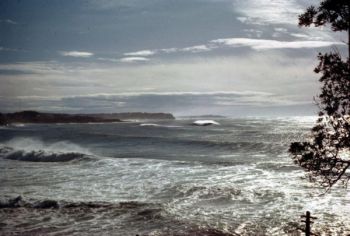
|
|
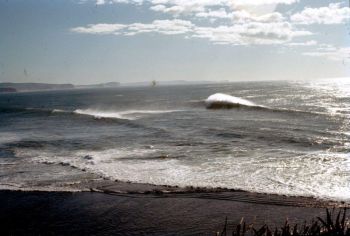
|
Photographs courtesy of Dave
Sams.
10. Did you gradually progress to a stand-up board or
was the transition pretty quick? When did you last ride a paipo?
The
transition to a board began in 1965, and as mentioned above I was
pretty
much riding only a board in 1966, as there were some really big swells
that year and I was going to Hawaii at the end of the year.
Dave Sams in the pocket making his turn at the Makaha Championships, December 1966. There were eight people in the heats!
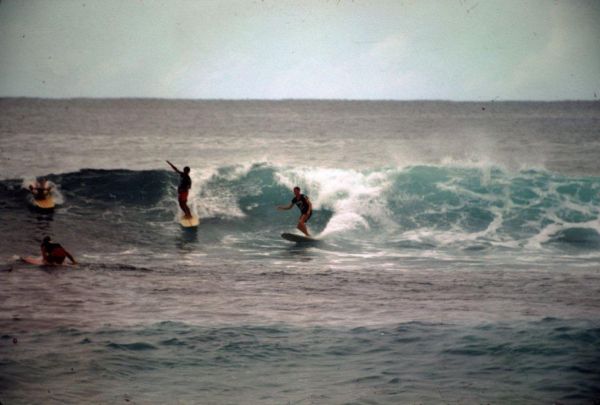
Photograph courtesy of Dave
Sams.
I probably last rode the paipo in the early-1970s. I can recall how
hard I thought it was after paddling a board, but there was still that
thrill at the speed.
11. Did you know Gary Sharp or Geoff Gale? They rode
wood boards prone and kneeling in the 1970s.
Can’t say I do but by then I was pretty much
into boardriding only. [See Note 6 for
information on Sharp and Gale.]
12. Any other comments?
You had to be pretty fit to ride those boards
so just as well I was
young, but with the crowds these days I can see why the boogie boarders
are seeking out more and more marginal waves.
I just feel very lucky to have been around at that time (early-1960s
and
on). When I started there used to be hordes of body surfers, well and
truly outnumbering boardriders, but by about 1962-1963, the situation
had
completely reversed.
Bodysurfers swimming out
at Pipeline, November 1970.
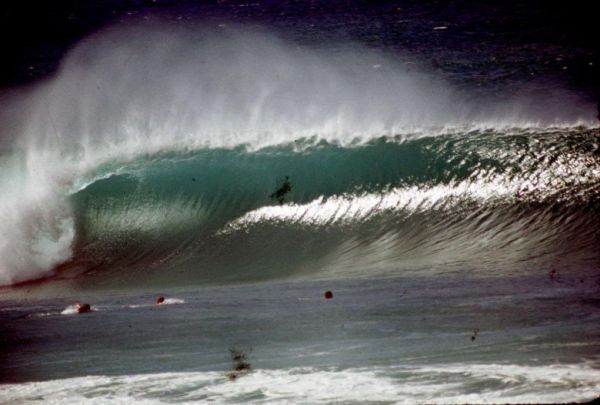
Photograph courtesy of Dave
Sams.
Really appreciate being able to have a lot of good times and surfs in
the memory bank!
Clean-up wave at Waimea
Bay, December 1967.
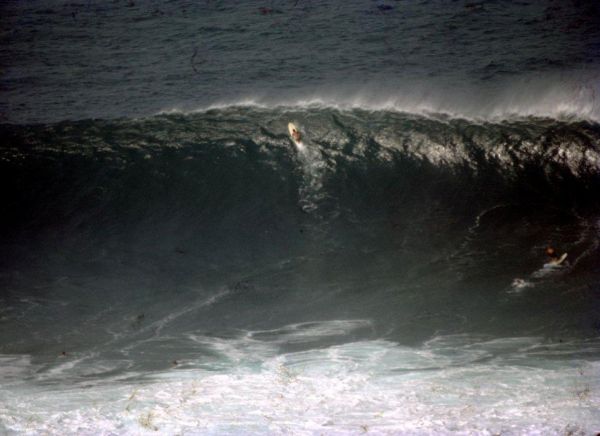
Photograph courtesy of Dave
Sams.
|
Notes:
Note 1: In The Surfin'ary: A Dictionary of Surfing Terms and
Surfspeak, Trevor
Cralle describes a coolite as an Australian brand name for a Styrofoam
trainee surfboard. Cralle cites Mark Warren's Atlas of Australian
Surfing as the source for this definition. The Encyclopaedia of
Surfing
notes that the average coolite was five feet long and 20 inches wide,
with one or two long, narrow finlike runners along the bottom. For more
information and pictures, see Geoff Cater's website, pods for primates:
a catalogue of surfboards in Australia since 1900.
The surfoplane was the forerunner of the surf mat. For more
information, see the John
Ruffles paipo interview.
Note 2: See the
Jim Growney paipo interview and video, Paipo Surfing 1958-65, featuring
Jim Growney and John Waidelich.
Note 3: The book: Kelly, John M. (1965). Surf and Sea.
New York: A.S. Barnes. See a book summary, analysis and additional
comments at http://mypaipoboards.org/pubs/BookSummaries.shtml#KellyJohn.
Note 4:
For more information see the Surf
Guide and
Surfing International magazine articles by Val Valentine; the Val
Valentine film posters; and, the Paul Swanson article in The
Surfers Journal.
Note 5: See the paipo
interview with Bill
Clymer.
Note 6: Gary Sharp and Geoff Gale. Inspired
by George Greenough in the late-1960s, Gary and Geoff, who lived at
Newport, built and rode ply bellyboards. Gary rode prone and
Geoff
was a kneerider. Geoff's board was made from 5/16" Bruynzeel marine
grade
plywood, measured 48 inches long by 22 inches wide, and featured a
round tail and a single fin. Geoff progressed to a
small balsa/glass board made by Newport local Dave Jones, and then to
two foam/glass
kneeboards by Paul Chadwick from Avalon.
This board of Gary's was
made about 10 years ago and is still surfed.
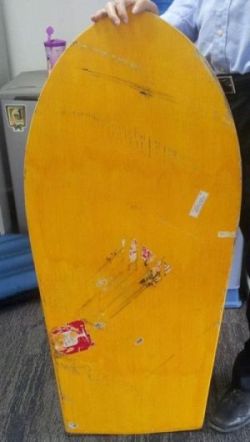
Photograph courtesy of Gary Sharp.
|
|